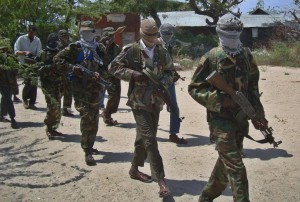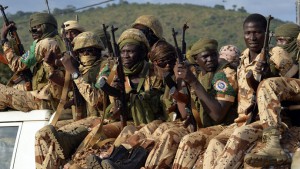The Islamic State group claimed responsibility Monday for its first terrorist attack in Somalia. In an official statement circulated on social media, the extremist group said its fighters detonated an improvised explosive device (IED) targeting a military vehicle belonging to African Union peacekeeping forces on the outskirts of Mogadishu, the country’s sprawling capital. The blast damaged the vehicle, but it was not immediately clear whether anybody was either killed or wounded, the militant group aka either ISIL or ISIS said in its statement.
However, an African Union Mission in Somalia representative, Lt. Col. Joe Kibet, told International Business Times by phone the claim was “not true,” saying the explosion did not damage the vehicle and that there were neither deaths nor injuries. Speaking for Somalia’s Ministry of Internal Security, Abdikamil Moalim Shukri also denied the claim in a brief phone interview Monday.
It’s the first time ISIS has officially declared its involvement in an operation in Somalia. The incident signals the extremist group’s desire to make inroads in a war-torn region dominated by its rival, al Qaeda affiliate al-Shabab. While it’s no easy task, increasing its base in Somalia could translate into big rewards for ISIS, including access to Africa’s longest coastline and the neighboring nations of Djibouti, Ethiopia and Kenya, all key U.S. allies.
“Setting off an IED is hardly a major achievement in Somalia,” said Matt Bryden, a Somalia expert and director of Sahan Research, a think tank based in the Kenyan capital of Nairobi. “But it does testify to the presence of Islamic State sympathizers on the ground in Somalia, and the potential for the group to inspire fissures among al-Shabab fighters and sympathizers.”
Somalia’s conflict-ridden past, high unemployment rate, Muslim-majority population and Western ties make it a hot spot for jihadi groups, so ISIS has been courting al-Shabab members there for some time. The Syria-based extremist group released a recruitment video last year that showed Somali fighters urging their compatriots to join ISIS.
Somalia would be a strategic move for ISIS. The African country sits close to the world’s busiest shipping routes in the Gulf of Aden. The East African region also hosts U.S. military troops and bases, and is the recipient of millions of dollars in U.S. aid and investment.
“Looking at Somalia, ISIL is trying to insert itself and then may threaten to move into Kenya,” Rose Gottemoeller, the U.S. State Department’s undersecretary for arms control and international security, reportedly said at a roundtable in Johannesburg, South Africa, in December.
But the push has had marginal success thus far. Al-Shabab commander Hassan Mohamed, aka Hassan Fanah, was arrested by Somali forces in Mogadishu’s Kahda district Sunday night. He had reportedly defected from al-Shabab and joined ISIS at the end of last year, according toMareeg.com. Another senior al-Shabab commander in Somalia’s semiautonomous Puntland region reportedly defected from the group in October and pledged allegiance to ISIS leader Abu Bakr al-Baghdadi. He took about 20 of his followers with him, but the move represented a small split in the ranks as the vast majority of al-Shabab members in the region have remained loyal to the group.
There is also a new group calling itself Jahba East Africa, which this month gave bayah, or an oath of allegiance, to al-Baghdadi and recognized him as the “rightful khalifa [leader] of all Muslims.” The group may be made up of former members of al-Shabab. A representative said the group included fighters not only in Somalia but also in Kenya, Tanzania and Uganda and condemned al-Shabab for being a “psychological and physical prison,” according to the SITE Intelligence Group, which monitors terrorist activity.
“The sentiment that Jabha reflects in its messaging is real: There is a growing Islamic State constituency across East Africa. But whether or not it has the potential to develop as a terrorist group remains to be seen,” Sahan Research’s Bryden said in an interview Monday. “Over time, if ISIS continues to project an aura of success and expansion, that could prove a challenge to al-Shabab’s cohesion and integrity.”
Controlling swaths of territory in Iraq and Syria, ISIS has gained ground in recent months with its branches in both North Africa and West Africa, amassing supporters and territory, but the militant group has been struggling to establish itself in East Africa for a number of reasons. While Somalia’s location makes it an appealing place to establish a base, its site also makes it a difficult one. Much of the country is within reach of the government security forces, peacekeeping troops or armies of neighboring countries.
“ISIS has not yet managed to establish a meaningful foothold in Somalia,” Bryden said. “Its current presence, in the remote northeastern highlands, is isolated enough to provide a degree of security, but also consigns the group to irrelevance.”
Analysts have estimated there are several thousand al-Shabab fighters in Somalia, and the group has threatened to kill any potential turncoats, which has likely choked ISIS’ recruitment efforts. Most of the defectors have been young fighters.
More al-Shabab members may choose to swap sides in the event they see immense benefits in defecting, such as better pay or higher ranks. For now, though, the group’s emir, Ahmed Omar, aka Abu Ubaydah, has clearly chosen to remain aligned with al Qaeda.
“There are signs that ISIS is gaining a very small toehold in the region. But they’ve been trying very, very hard to woo al-Shabab into the ISIS fold,” said Joshua Meservey, policy analyst for Africa and the Middle East at the Heritage Foundation, a conservative think tank in Washington. “This is a group with real teeth, and joining ISIS would be a feather in the cap.”
Al Qaeda and ISIS have a shared goal of establishing an Islamic caliphate ruled by a strict version of Sharia and they have a common enemy: the West and its allies. But they are locked in competition for resources, recruits and operational spaces. There are also fundamental differences between the two groups.
Al Qaeda leadership views the establishment of a caliphate as a long-term project and sees the implementation of Islamic law as a slow process, in contrast to ISIS and its affiliates, which have declared caliphates quickly. Al Qaeda has traditionally relied on donor funding, while ISIS is comparatively more dependent on illicit activities such as selling oil on the black market. ISIS is also more brutal than al Qaeda, using extreme violence to attract attention and recruit followers, a tactic al Qaeda leadership has shunned.
Al Qaeda already has the upper hand in East Africa because its affiliate has had a longstanding presence in Somalia. Al-Shabab, whose name means “The Youth,” emerged in 2006 from the now-defunct Islamic Courts Union, which once ruled Mogadishu. The Sunni extremist group launched its own insurgency in major Somali cities in 2009, taking control of Mogadishu and southern Somalia until it was pushed out by domestic and foreign forces around 2012.
Al-Shabab frequently targets officials and peacekeeping forces in its efforts to topple Somalia’s Western-backed government, as well as civilians and non-Muslims. Although it’s based in Somalia, its fighters have launched deadly attacks in neighboring countries such as Kenya. Many areas of Somalia are still under al-Shabab’s control, and the militants have increased efforts in recent months to recapture lost territories.
Decades of civil war has ravaged much of Somalia’s economic infrastructure, government structures and other institutions. Clan warlords have battled for power in the country after the collapse of a military dictator’s regime in the early 1990s. After years of interim authority, a federal government headed by the president and parliament was established in 2012. But Somalia’s internationally recognized government has failed to assert central authority over the nation, which, in conjunction with a high unemployment rate, has created a niche for armed groups and piracy. It also leaves the door open for al-Shabab to expand or for ISIS to gain a foothold.
The youth unemployment rate in Somalia is among the highest in the world, at 67 percent, according to the United Nations Development Program. That figure is even higher for woman and in certain areas of the country. Somalia also has one of the lowest rates of school enrollment, with more than 80 percent of primary-age children no longer in school or have never attended. These issues verge on catastrophic, given that more than 70 percent of Somalia’s population of 10.5 million is under 35. And with this population almost entirely Muslim, Somalia is highly vulnerable to extremism and radicalization.
With few or no opportunities, many young Somalis have turned to joining militias or piracy as solutions to their problems in cases where migrating is not an option. An armed pirate can earn between $6,000 and $10,000 on a $1 million ransom, according to a 2008 report commissioned by the U.N. Militant groups such as al-Shabab also make tempting promises of income from their illicit dealings. ISIS could compete by offering even higher wages.
“The U.S. really needs to pay attention and remain engaged on Somalia,” the Heritage Foundation’s Meservey said.
ibtimes.com












